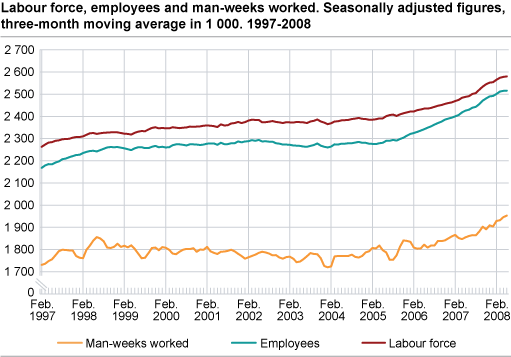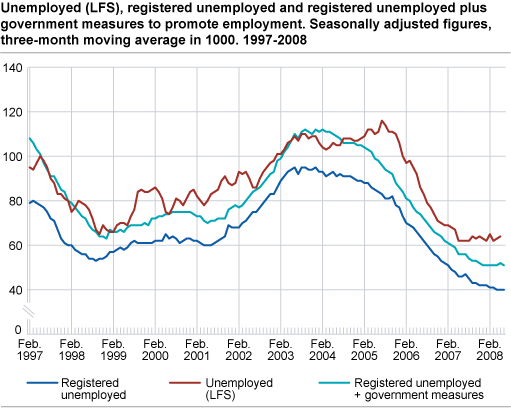Content
Published:
This is an archived release.
Higher labour force participation
The labour force participation rate was 74.1 per cent in the second quarter of 2008, up 1.3 percentage points from the same quarter in 2007. The growth in employment was strongest within public and private service industries.
Seasonally adjusted figures: Stable unemploymentAdjusted for seasonal variations, unemployment was unchanged, while employment continued to rise, from the second quarter of 2007 to the second quarter of 2008. The growth in employment was waning. Adjustments for seasonal variations allow for the analysis of current developments in the labour market, and serve as an alternative to comparisons with the corresponding quarter in the previous year. Seasonally adjusted figures are presented in a separate article . |
Omission in the data collection
Due to an omission in the data collection during the first half-year of 2008, the employment figures have become too high, approximately by 6 000 in the first quarter and by 12 000 in the second quarter of 2008. This affects the employment figures for the age group 15-19 and consequently also for the whole population aged 15-74. The figures on unemployment are not affected. The tables are not adjusted, but in this article we have made adjustments.
This omission, however, does not affect the seasonal adjusted figures presented in a separate article.
Higher participation rate
Adjusted for the omission in the data collection, there were 90 000 more people in the labour force in the second quarter of 2008 than in the corresponding quarter last year. The labour force is the sum of the people employed and unemployed. In the same period, the working-age population (aged 15-74) rose by 61 000. The labour force participation rate (the labour force in percent of the working-age population) was 74.1 per cent, compared to 72.8 per cent in the same quarter last year. The labour force participation rate increased equally much for women and men.
Growth in private and public service industries
From the second quarter of 2007 to the second quarter of 2008, employment rose by 87 000 people (based on adjusted figures). The strongest growth in employment was within financial intermediation, health and social work. About 70 per cent of the increase in total employment took place in these industries.
More full-time employment
Full-time employment is up by approximately 70 000, 40 per cent of it among women. The share with full-time employment among women is 57 per cent, while the share for men is 87 percent. Average settled working hours for men were 37.3 hours per week, compared with 31.1 hours for women. Easter was in the first quarter of 2008, while it was in the second quarter of 2007. This affects the numbers of people temporarily absent from work, especially on holyday, and there was a large decrease in these numbers from the second quarter of 2007 to the second quarter of 2008.
Stable share of employed people on temporary contracts
In total, 219 000 were on temporary contracts in the second quarter of 2008. This corresponds to 9.4 per cent of total employment, about the same as in the second quarter last year. Education, health and social work and hotels and restaurants had the largest shares of employees on temporary contracts. Those industries employed about half of all people on temporary contracts.
Stable number of unemployed
According to the Labor Force Survey (LFS), the number of unemployed was stable from the second quarter of 2007 to the second quarter of 2008. The increase of 3 000 people in the LFS is inside the error margin. The unemployment rate stood at 2.8 per cent. The number of people registered unemployed at the Labour and Welfare Organisation (NAV) showed a decline of 7 000 over the same period. The discrepancy between the two sources mainly comes from an increase in the number of unemployed in the LFS not found in the register with NAV.
Both the number of people unemployed as well as the share of the unemployed that had a short duration of their job search (1-4 weeks) went up from the second quarter of 2007 to the second quarter of 2008. This may indicate an increase of the inflow to unemployment.
The number of underemployed down
Underemployed people are employees with part-time as settled working hours who have tried to find more work. The number of underemployed was 68 000 in the second quarter of 2008, about the same as in the second quarter of 2007. In the second quarter of 2008, the underemployed represented 9.9 per cent of all part-time employees, down from 10.8 per cent in the same quarter in 2007.
When accounting for the fact that many unemployed and most underemployed are looking for less than full-time work, these two groups together wanted work equivalent to a total of 80 000 full-time positions in the second quarter of 2008 - about the same as in the second quarter of 2007. Among the unemployed, more people wanted part-time work. These may be people in education seeking part-time employment.
Tables:
- Table 1. Population aged 15-74(1) in the labour force, man-weeks worked, unemployed (LFS)(2), registered unemployed persons and persons employed by government measures (NAV). 1000 and per cent
- Table 2. Population aged 15-74(1) in the labour force, employed persons and unemployed persons by sex (LFS)(2). 1000 and per cent
- Table 3. Persons in the labour force and employed persons aged 15-74, by age and sex (LFS). 1 000 and per cent.
- Table 4. Population aged 15-74, employed persons by contractual/usual working hours per week(1) and unemployed persons by age and sex (LFS). 1000
- Table 5. Persons in the labour force aged 15-74 by age and sex. 1000 and as per cent of all in each group
- Table 6. Employed persons aged 15-74, by sex and settled/usual working hours pr week (LFS). 1 000
- Table 7. Population aged 15-74, by main activity, part-time employment1 and age (LFS). 1 000
- Table 8. Employed persons aged 15-74 by major industry division (LFS). 1 000
- Table 9. Number of man-hours worked per week1, by industry division (LFS).1 000
- Table 10. Employed persons,total, and employed persons at work, by status and sex. Number of man-weeks worked1 and actual working hours per week (LFS).
- Table 11. Employed persons aged 15-74 and absence from work(1) during the whole reference week by reason for absence and sex (LFS). 1000 and per cent
- Table 12. Employees aged 15-74 with temporary jobs, by major industry division (LFS). 1000 and as per cent of all employees
- Table 13. Unemployed persons aged 15-74 by sex and age (LFS). 1000 and per cent
- Table 14. Unemployed persons aged 15-74 by duration of job search (LFS). 1000 and per cent
- Table 15. Unemployed persons aged 15-74, by main activity (LFS). 1 000
- Table 16. Unemployed and underemployed persons aged 15-74, by sex and desired working hours per week. Number of man-weeks (of 37,5 hours) supplied (LFS). 1000
- Table 18. Persons in the labour force aged 15-741, by sex and region(LFS)2. 1 000 and in per cent of total
- Table 19. Employed persons aged 15-74, by sex and region (LFS) 1 000
- Table 20. Employed persons aged 15-74, by sex and regions (LFS) as per cent of all inn each group
- Table 21. Employed persons, by some major industry division and region (LFS). 1997-2007. 1 000
Contact
-
Arbeidsmarked og lønn
E-mail: arbeidsmarked@ssb.no
-
Erik Herstad Horgen
E-mail: erik.horgen@ssb.no
tel.: (+47) 93 08 68 62
-
Ole Sandvik
E-mail: ole.sandvik@ssb.no
tel.: (+47) 99 04 82 06
-
Håvard Hungnes Lien
E-mail: havard.lien@ssb.no
tel.: (+47) 40 90 26 06


